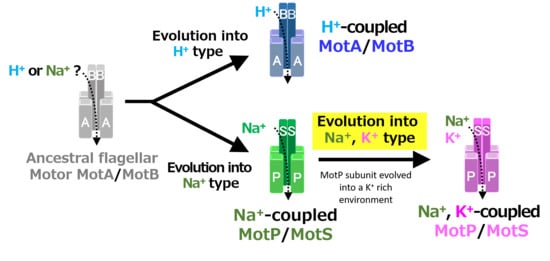MotP Subunit is Critical for Ion Selectivity and Evolution of a K+-Coupled Flagellar Motor
Abstract
:1. Introduction
2. Materials and Methods
2.1. Bacterial Strains and Plasmids
2.2. Cloning of the motP/motS Genes with the Pre- and Post-Regions of B. trypoxylicola
2.3. Cloning of the motP/motS Genes of B. trypoxylicola into pBAD24
2.4. Cloning of the Hybrid Stator Gene into the pGEM7zf (+) Vector and Integration Vector pAX01 for Bacillus Subtilis
2.5. Construction of B. subtilis Integration Mutants Expressing the Hetero Hybrid Stator
2.6. Growth Media and Growth Conditions for Growth and Swimming Assays
2.7. Swimming Assay of Mutant Strains Expressing Hybrid Stators
2.8. Cell Harvest Method for Swimming Assay and Swimming Video Recording Analysis
2.9. Measurement of Intracellular Potassium Concentration of E. coli HB-pBAD, TK-pBAD, TK-BaPS, and TK-BtPS
2.10. Phylogenetic Analysis and Multiple Alignment of the Transmembrane Domain Region of the B. trypoxylicola MotS Subunit
3. Results
3.1. Na+- or K+-Dependent Growth Capacities of Alkaliphiles, B. trypoxylicola, B. alcalophilus and B. pseudofirmus at pH 9.0
3.2. Swimming Assay of B. trypoxylicola, B. alcalophilus, and B. pseudofirmus under Various K+ and Na+ Concentrations
3.3. Identification of MotP/MotS Operon of B. trypoxylicola
3.4. Swimming Assay of an E. coli Stator-Deficient Strain Expressing Bt-MotP/Bt-MotS
3.5. Growth of an E. coli K+ uptake System-Deficient Strain Expressing Bt-MotP/Bt-MotS and Measurement of the Intracellular K+ Concentration
3.6. Swimming Assay of E. coli Stator-Deficient Strain Expressing Bt-MotP/Bt-MotS With/Without a Flagellar Motor Inhibitor
3.7. Functional Analysis of the Hybrid Stator With the Na+-Coupled MotP/MotS Subunit Replaced With the Na+- and K+-Coupled MotP/MotS Subunit
4. Discussion
5. Conclusions
Supplementary Materials
Author Contributions
Funding
Acknowledgments
Conflicts of Interest
References
- Minamino, T.; Imada, K. The bacterial flagellar motor and its structural diversity. Trends Microbiol. 2015, 23, 267–274. [Google Scholar] [CrossRef] [PubMed]
- Minamino, T.; Terahara, N.; Kojima, S.; Namba, K. Autonomous control mechanism of stator assembly in the bacterial flagellar motor in response to changes in the environment. Mol. Microbiol. 2018, 109, 723–734. [Google Scholar] [CrossRef] [PubMed] [Green Version]
- Ito, M.; Takahashi, Y. Nonconventional cation-coupled flagellar motors derived from the alkaliphilic Bacillus and Paenibacillus species. Extremophiles 2017, 21, 3–14. [Google Scholar] [CrossRef] [PubMed]
- Berg, H.C. The rotary motor of bacterial flagella. Ann. Rev. Biochem. 2003, 72, 19–54. [Google Scholar]
- Sowa, Y.; Berry, R.M. Bacterial flagellar motor. Q. Rev. Biophys. 2008, 41, 103–132. [Google Scholar] [CrossRef] [PubMed] [Green Version]
- Minamino, T.; Imada, K.; Namba, K. Molecular motors of the bacterial flagella. Curr. Opin. Struct. Biol. 2008, 18, 693–701. [Google Scholar] [CrossRef]
- Terashima, H.; Kawamoto, A.; Morimoto, Y.V.; Imada, K.; Minamino, T. Structural differences in the bacterial flagellar motor among bacterial species. Biophys. Physicobiol. 2017, 14, 191–198. [Google Scholar] [CrossRef] [Green Version]
- Kojima, S.; Blair, D.F. Solubilization and purification of the MotA/MotB complex of Escherichia coli. Biochemistry 2004, 43, 26–34. [Google Scholar]
- Braun, T.F.; Al-Mawsawi, L.Q.; Kojima, S.; Blair, D.F. Arrangement of core membrane segments in the MotA/MotB proton-channel complex of Escherichia coli. Biochemistry 2004, 43, 35–45. [Google Scholar]
- Zhou, J.; Lloyd, S.A.; Blair, D.F. Electrostatic interactions between rotor and stator in the bacterial flagellar motor. Proc. Natl. Acad. Sci. USA 1998, 95, 6436–6441. [Google Scholar]
- Reid, S.W.; Leake, M.C.; Chandler, J.H.; Lo, C.J.; Armitage, J.P.; Berry, R.M. The maximum number of torque-generating units in the flagellar motor of Escherichia coli is at least 11. Proc. Natl. Acad. Sci. USA 2006, 103, 8066–8071. [Google Scholar] [CrossRef] [PubMed] [Green Version]
- Manson, M.D.; Tedesco, P.; Berg, H.C.; Harold, F.M.; Van der Drift, C. A protonmotive force drives bacterial flagella. Proc. Natl. Acad. Sci. USA 1977, 74, 3060–3064. [Google Scholar] [PubMed] [Green Version]
- Macnab, R.M. The bacterial flagellum: Reversible rotary propellor and type III export apparatus. J. Bacteriol. 1999, 181, 7149–7153. [Google Scholar] [PubMed]
- Li, N.; Kojima, S.; Homma, M. Sodium-driven motor of the polar flagellum in marine bacteria Vibrio. Genes Cells 2011, 16, 985–999. [Google Scholar] [CrossRef] [PubMed]
- Ito, M.; Hicks, D.B.; Henkin, T.M.; Guffanti, A.A.; Powers, B.D.; Zvi, L.; Uematsu, K.; Krulwich, T.A. MotPS is the stator-force generator for motility of alkaliphilic Bacillus, and its homologue is a second functional Mot in Bacillus subtilis. Mol. Microbiol. 2004, 53, 1035–1049. [Google Scholar] [CrossRef]
- Fujinami, S.; Terahara, N.; Krulwich, T.A.; Ito, M. Motility and chemotaxis in alkaliphilic Bacillus species. Future Microbiol. 2009, 4, 1137–1149. [Google Scholar] [CrossRef] [Green Version]
- Fujinami, S.; Terahara, N.; Lee, S.; Ito, M. Na+ and flagella-dependent swimming of alkaliphilic Bacillus pseudofirmus OF4: A basis for poor motility at low pH and enhancement in viscous media in an “up-motile” variant. Arch. Microbiol. 2007, 187, 239–247. [Google Scholar] [CrossRef]
- Kojima, S.; Blair, D.F. The bacterial flagellar motor: Structure and function of a complex molecular machine. Int. Rev. Cytol. 2004, 233, 93–134. [Google Scholar] [PubMed]
- Paulick, A.; Delalez, N.J.; Brenzinger, S.; Steel, B.C.; Berry, R.M.; Armitage, J.P.; Thormann, K.M. Dual stator dynamics in the Shewanella oneidensis MR-1 flagellar motor. Mol. Microbiol. 2015, 96, 993–1001. [Google Scholar] [CrossRef]
- Terahara, N.; Fujisawa, M.; Powers, B.; Henkin, T.M.; Krulwich, T.A.; Ito, M. An intergenic stem-loop mutation in the Bacillus subtilis ccpA-motPS operon increases motPS transcription and the MotPS contribution to motility. J. Bacteriol. 2006, 188, 2701–2705. [Google Scholar] [CrossRef] [Green Version]
- Terahara, N.; Krulwich, T.A.; Ito, M. Mutations alter the sodium versus proton use of a Bacillus clausii flagellar motor and confer dual ion use on Bacillus subtilis motors. Proc. Natl. Acad. Sci. USA 2008, 105, 14359–14364. [Google Scholar] [CrossRef] [Green Version]
- Terahara, N.; Sano, M.; Ito, M. A Bacillus flagellar motor that can use both Na+ and K+ as a coupling ion is converted by a single mutation to use only Na+. PLoS ONE 2012, 7, e46248. [Google Scholar]
- Imazawa, R.; Takahashi, Y.; Aoki, W.; Sano, M.; Ito, M. A novel type bacterial flagellar motor that can use divalent cations as a coupling ion. Sci. Rep. 2016, 6, 19773. [Google Scholar] [CrossRef]
- Asai, Y.; Yakushi, T.; Kawagishi, I.; Homma, M. Ion-coupling determinants of Na+-driven and H+-driven flagellar motors. J. Mol. Biol. 2003, 327, 453–463. [Google Scholar]
- Ito, M.; Terahara, N.; Fujinami, S.; Krulwich, T.A. Properties of motility in Bacillus subtilis powered by the H+-coupled MotAB flagellar stator, Na+-coupled MotPS or hybrid stators MotAS or MotPB. J. Mol. Biol. 2005, 352, 396–408. [Google Scholar] [PubMed] [Green Version]
- Zhou, J.; Sharp, L.L.; Tang, H.L.; Lloyd, S.A.; Billings, S.; Braun, T.F.; Blair, D.F. Function of protonatable residues in the flagellar motor of Escherichia coli: A critical role for Asp 32 of MotB. J. Bacteriol. 1998, 180, 2729–2735. [Google Scholar] [PubMed]
- Aizawa, T.; Urai, M.; Iwabuchi, N.; Nakajima, M.; Sunairi, M. Bacillus trypoxylicola sp. nov., xylanase-producing alkaliphilic bacteria isolated from the guts of Japanese horned beetle larvae (Trypoxylus dichotomus septentrionalis). Int. J. Syst. Evol. Microbiol. 2010, 60, 61–66. [Google Scholar] [CrossRef]
- Attie, O.; Jayaprakash, A.; Shah, H.; Paulsen, I.T.; Morino, M.; Takahashi, Y.; Narumi, I.; Sachidanandam, R.; Satoh, K.; Ito, M.; et al. Draft Genome Sequence of Bacillus alcalophilus AV1934, a Classic Alkaliphile Isolated from Human Feces in 1934. Genome Announc. 2014, 2, e01175-14. [Google Scholar] [CrossRef] [Green Version]
- Gronstad, A.; Jaroszewicz, E.; Ito, M.; Sturr, M.G.; Krulwich, T.A.; Kolsto, A.B. Physical map of alkaliphilic Bacillus firmus OF4 and detection of a large endogenous plasmid. Extremophiles 1998, 2, 447–453. [Google Scholar]
- Ito, M.; Cooperberg, B.; Krulwich, T.A. Diverse genes of alkaliphilic Bacillus firmus OF4 that complement K+-uptake-deficient Escherichia coli include an ftsH homologue. Extremophiles 1997, 1, 22–28. [Google Scholar]
- Takahashi, Y.; Koyama, K.; Ito, M. Suppressor mutants from MotB-D24E and MotS-D30E in the flagellar stator complex of Bacillus subtilis. J. Gen. Appl. Microbiol. 2014, 60, 131–139. [Google Scholar]
- Spizizen, J. Transformation of biochemically deficient strains of Bacillus subtilis by deoxyribonucleate. Proc. Natl. Acad. Sci. USA 1958, 44, 1072–1078. [Google Scholar]
- Guzman, C.A.; Piatti, G.; Walker, M.J.; Guardati, M.C.; Pruzzo, C. A novel Escherichia coli expression-export vector containing alkaline phosphatase as an insertional inactivation screening system. Gene 1994, 148, 171–172. [Google Scholar] [CrossRef]
- Grundy, F.J.; Henkin, T.M. The rpsD gene, encoding ribosomal protein S4, is autogenously regulated in Bacillus subtilis. J. Bacteriol. 1991, 173, 4595–4602. [Google Scholar] [PubMed] [Green Version]
- Promega Protocols and Applications Guide, 3rd ed.; Promega: Madison, WI, USA, 1996; pp. 45–46.
- Horton, R.M.; Cai, Z.L.; Ho, S.N.; Pease, L.R. Gene splicing by overlap extension: Tailor-made genes using the polymerase chain reaction. Biotechniques 1990, 8, 528–535. [Google Scholar] [PubMed]
- Cohen-Bazire, G.; Sistrom, W.R.; Stanier, R.Y. Kinetic studies of pigment synthesis by non-sulfur purple bacteria. J. Cell. Physiol. 1957, 49, 25–68. [Google Scholar]
- Epstein, W.; Buurman, E.; McLaggan, D.; Naprstek, J. Multiple mechanisms, roles and controls of K+ transport in Escherichia coli. Biochem. Soc. Trans. 1993, 21, 1006–1010. [Google Scholar] [PubMed]
- Bakker, E. Cell K+ and K+ transport systems in prokaryotes. In Alkali Cation Transport Systems in Prokaryotes; Bakker, E., Ed.; CRC Press: Boca Raton, FL, USA, 1993; pp. 205–224. [Google Scholar]
- Ito, M.; Guffanti, A.A.; Zemsky, J.; Ivey, D.M.; Krulwich, T.A. Role of the nhaC-encoded Na+/H+ antiporter of alkaliphilic Bacillus firmus OF4. J. Bacteriol. 1997, 179, 3851–3857. [Google Scholar]
- Atsumi, T.; McCarter, L.; Imae, Y. Polar and lateral flagellar motors of marine Vibrio are driven by different ion-motive forces. Nature 1992, 355, 182–184. [Google Scholar] [CrossRef]
- Bakker, E.P. The role of alkali-cation transport in energy coupling of neutrophilic and acidophilic bacteria: An assesment of methods and concepts. FEMS Microbiol. Rev. 1990, 75, 319–334. [Google Scholar]
- Booth, I.R. Regulation of cytoplasmic pH in bacteria. Microbiol. Rev. 1985, 49, 359–378. [Google Scholar] [PubMed]
- Kuroda, T.; Shimamoto, T.; Mizushima, T.; Tsuchiya, T. Mutational analysis of amiloride sensitivity of the NhaA Na+/H+ antiporter from Vibrio parahaemolyticus. J. Bacteriol. 1997, 179, 7600–7602. [Google Scholar] [CrossRef] [PubMed] [Green Version]
- Atsumi, T.; Sugiyama, S.; Cragoe, E.J., Jr.; Imae, Y. Specific inhibition of the Na+-driven flagellar motors of alkalophilic Bacillus strains by the amiloride analog phenamil. J. Bacteriol. 1990, 172, 1634–1639. [Google Scholar] [PubMed] [Green Version]
- Kojima, S.; Atsumi, T.; Muramoto, K.; Kudo, S.; Kawagishi, I.; Homma, M. Vibrio alginolyticus mutants resistant to phenamil, a specific inhibitor of the sodium-driven flagellar motor. J. Mol. Biol. 1997, 265, 310–318. [Google Scholar]
- Kojima, S.; Asai, Y.; Atsumi, T.; Kawagishi, I.; Homma, M. Na+-driven flagellar motor resistant to phenamil, an amiloride analog, caused by mutations in putative channel components. J. Mol. Biol. 1999, 285, 1537–1547. [Google Scholar] [PubMed] [Green Version]
- Sugiyama, S.; Cragoe, E.J., Jr.; Imae, Y. Amiloride, a specific inhibitor for the Na+-driven flagellar motors of alkalophilic Bacillus. J. Biol. Chem. 1988, 263, 8215–8219. [Google Scholar]
- Thongaram, T.; Hongoh, Y.; Kosono, S.; Ohkuma, M.; Trakulnaleamsai, S.; Noparatnaraporn, N.; Kudo, T. Comparison of bacterial communities in the alkaline gut segment among various species of higher termites. Extremophiles 2005, 9, 229–238. [Google Scholar] [CrossRef] [PubMed]
- Horikoshi, K. General Physiology of Alkaliphiles. In Extremophiles Handbook; Horikoshi, K., Ed.; Springer: Tokyo, Japan, 2011; pp. 99–118. [Google Scholar]
- Vedder, A. Bacillus alcalophilus n. sp.; benevens enkele ervaringen met sterk alcalische voedingsbodems. Anton. Leeuw. 1934, 1, 143–147. [Google Scholar]
- Bignell, D.E.; Oskarsson, H.; Anderson, J.M.; Ineson, P.; Wood, T.G. Structure, microbial associations and function of the so-called “mixed segment” of the gut in two soil-feeding termites, Procubitermes aburiensis and Cubitermes severus (Termitidae, Termitinae). J. Zool. 1983, 201, 445–480. [Google Scholar]
- Brune, A.; Kuhl, M. pH profiles of the extremely alkaline hindguts of soil-feeding termites (Isoptera: Termitidae) determined with microelectrodes. J. Insect Physiol. 1996, 42, 1121–1127. [Google Scholar]
- Thongaram, T.; Kosono, S.; Ohkuma, M.; Hongoh, Y.; Kitada, M.; Yoshinaka, T.; Trakulnaleamsai, S.; Noparatnaraporn, N.; Kudo, T. Gut of Higher Termites as a Niche for Alkaliphiles as Shown by Culture-Based and Culture-Independent Studies. Microb. Environ. 2003, 18, 152–159. [Google Scholar] [CrossRef] [Green Version]
- Ito, M.; Fujinami, S.; Terahara, N. Bioenergetics: Cell motility and chemotaxis of extreme alkaliphiles. In Extremophiles Handbook; Horikoshi, K., Ed.; Springer: Tokyo, Japan, 2011; pp. 141–162. [Google Scholar]
- Takekawa, N.; Nishiyama, M.; Kaneseki, T.; Kanai, T.; Atomi, H.; Kojima, S.; Homma, M. Sodium-driven energy conversion for flagellar rotation of the earliest divergent hyperthermophilic bacterium. Sci. Rep. 2015, 5, 12711. [Google Scholar] [CrossRef] [PubMed] [Green Version]

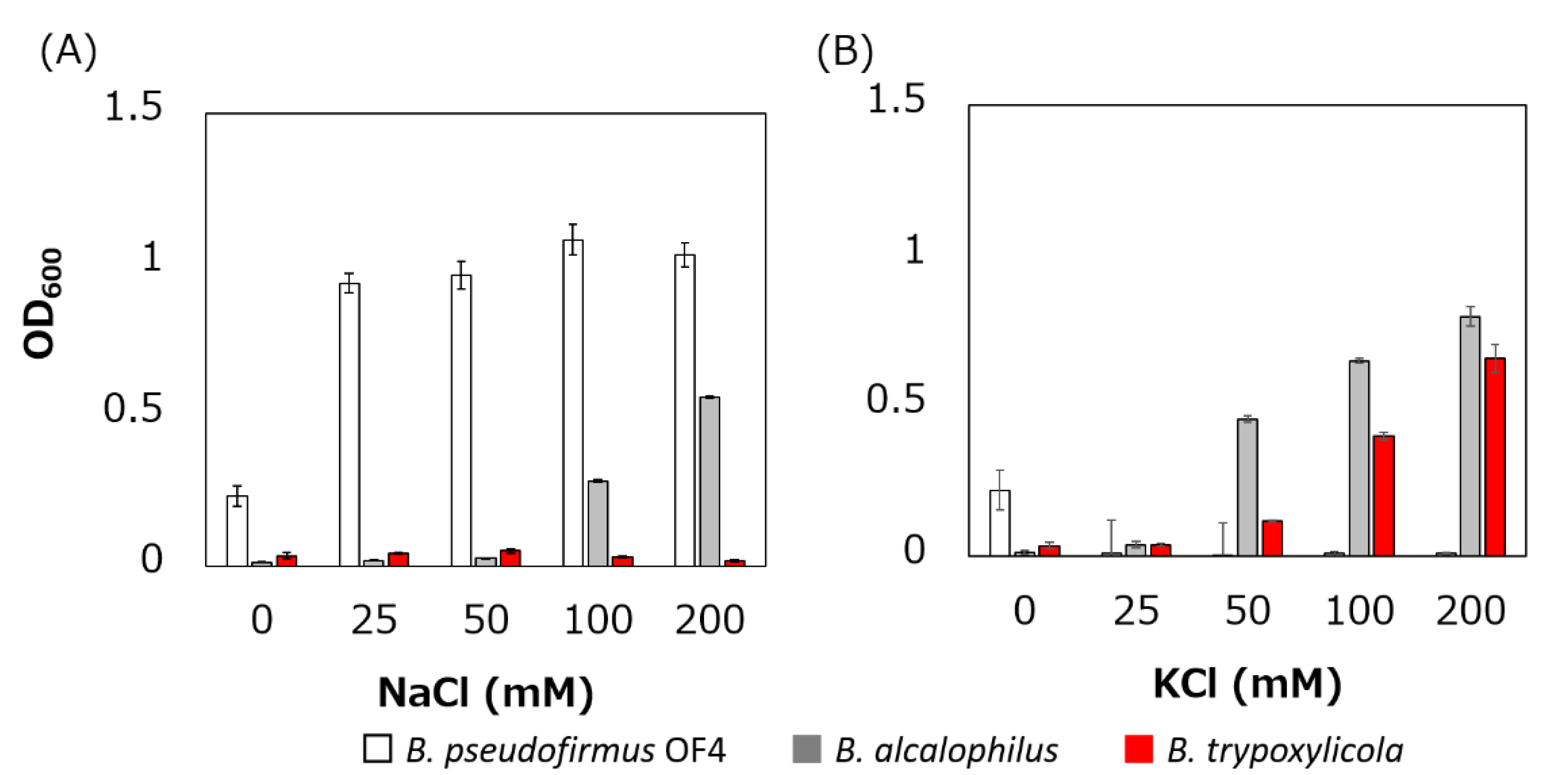

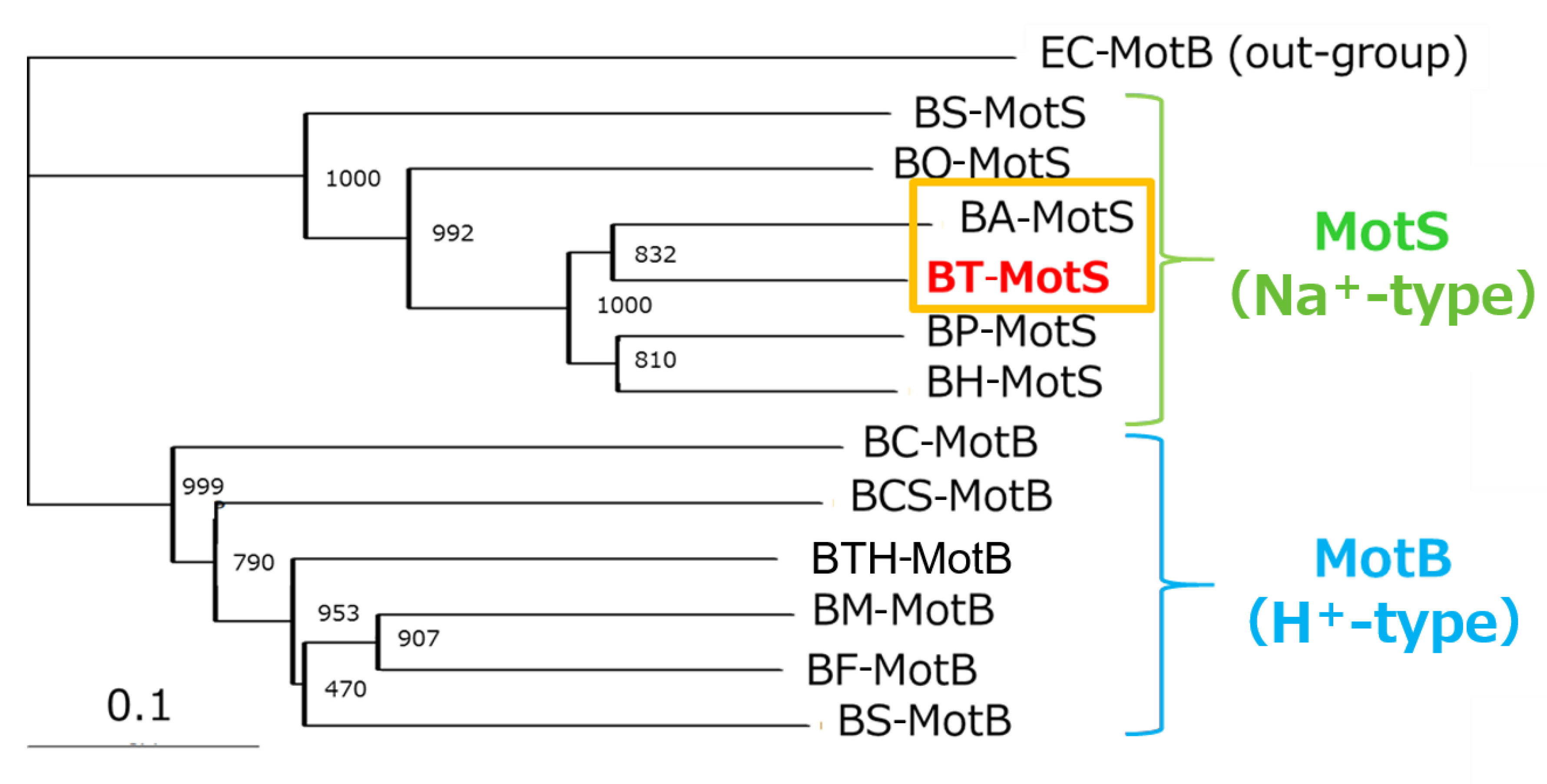
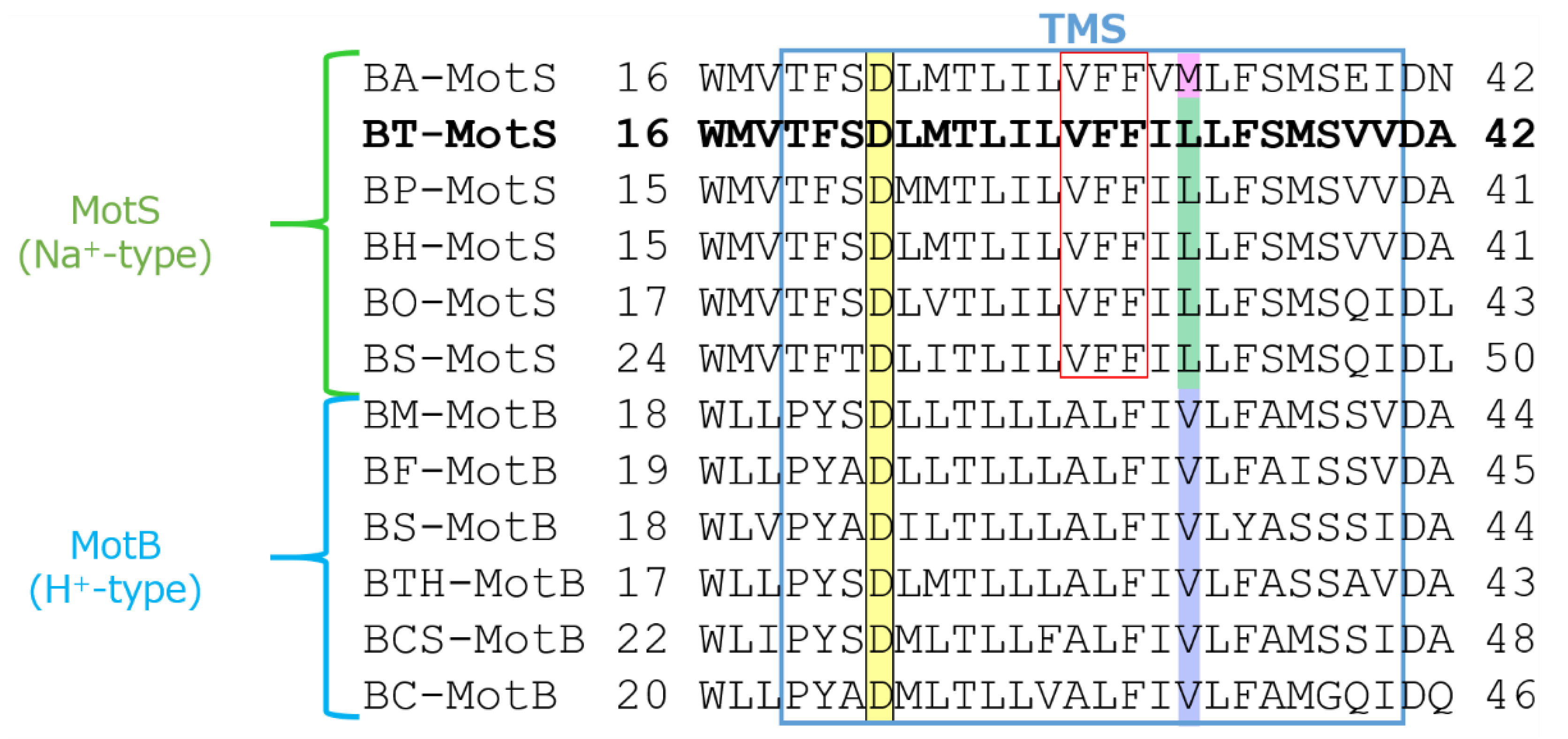

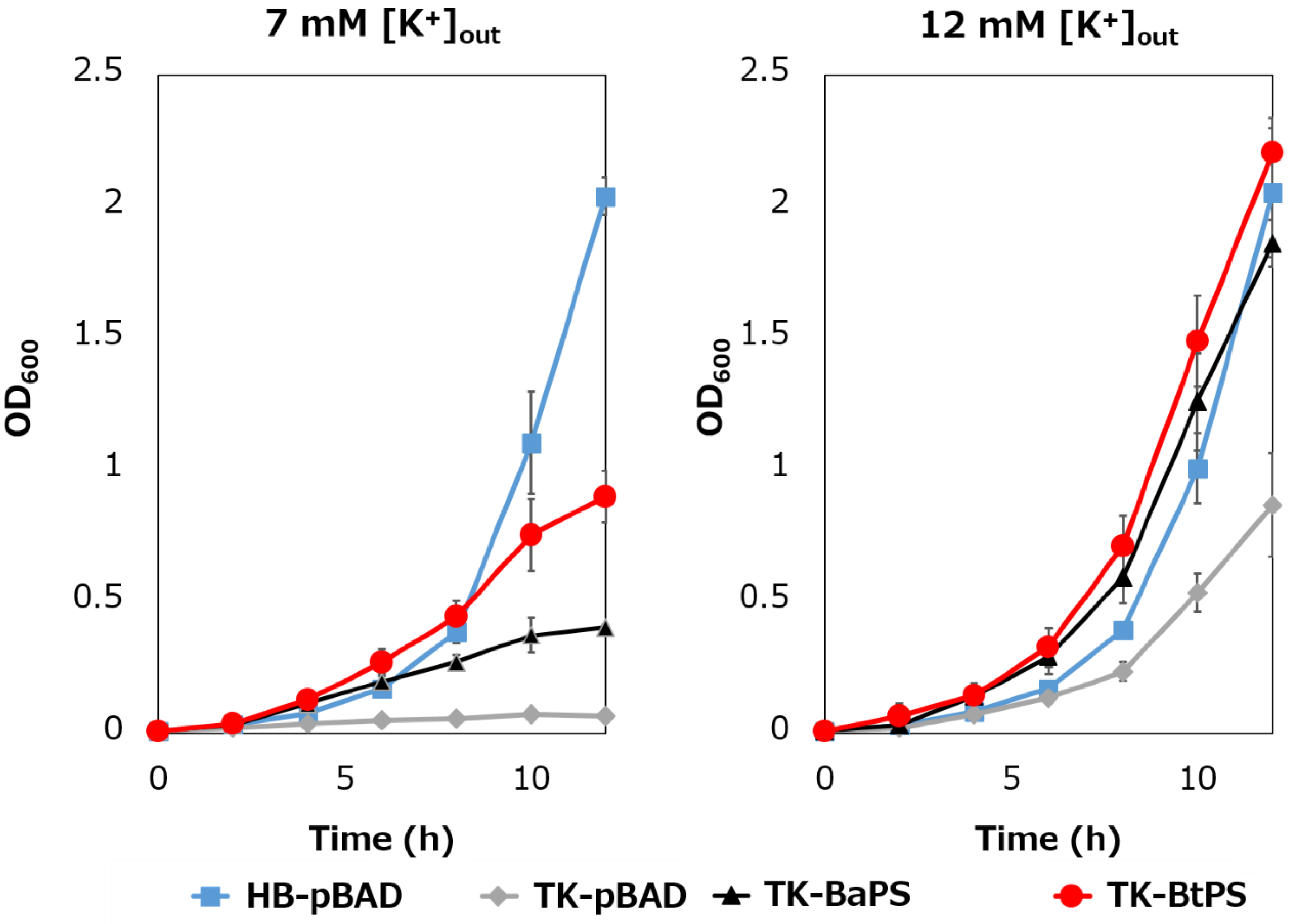



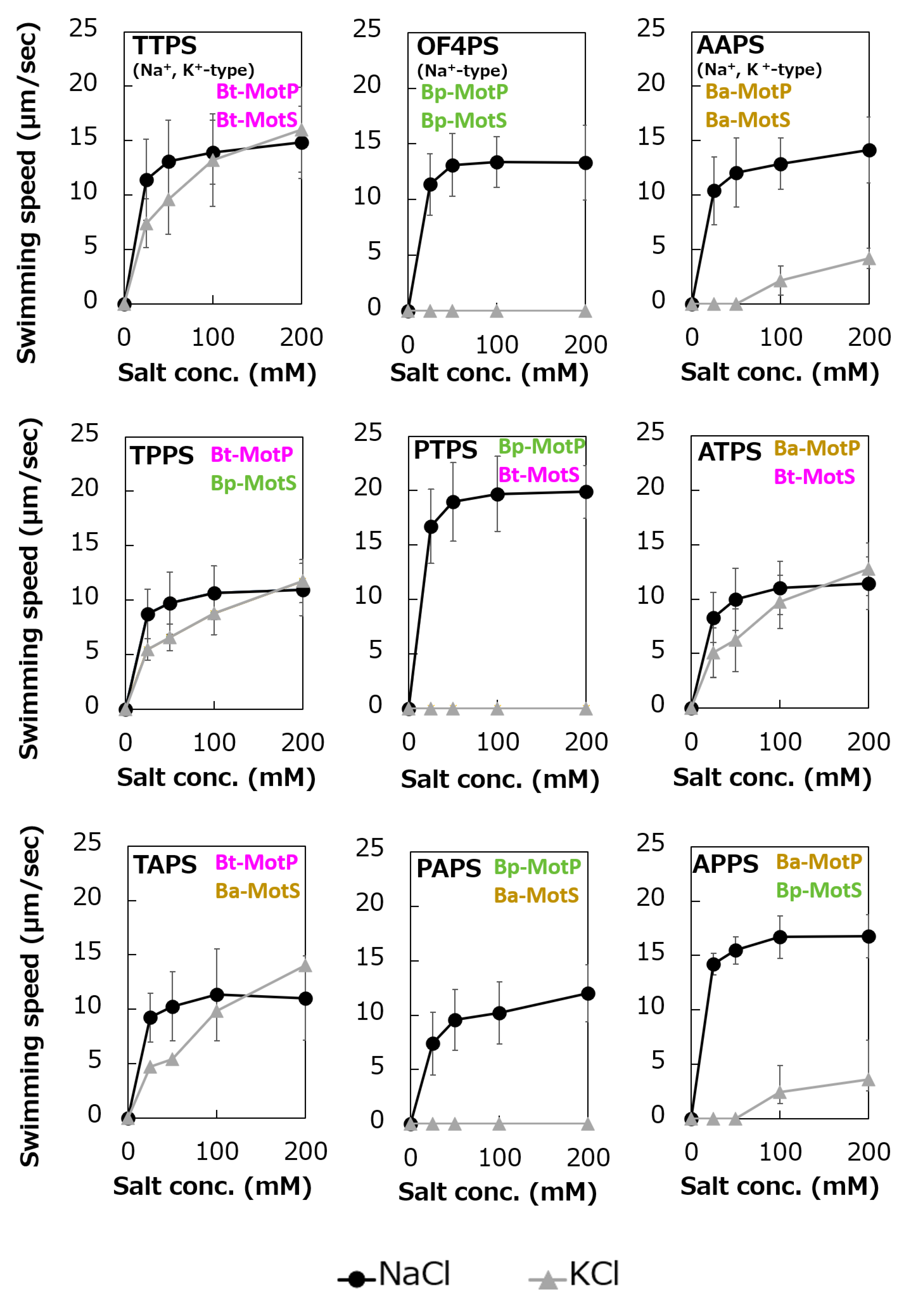
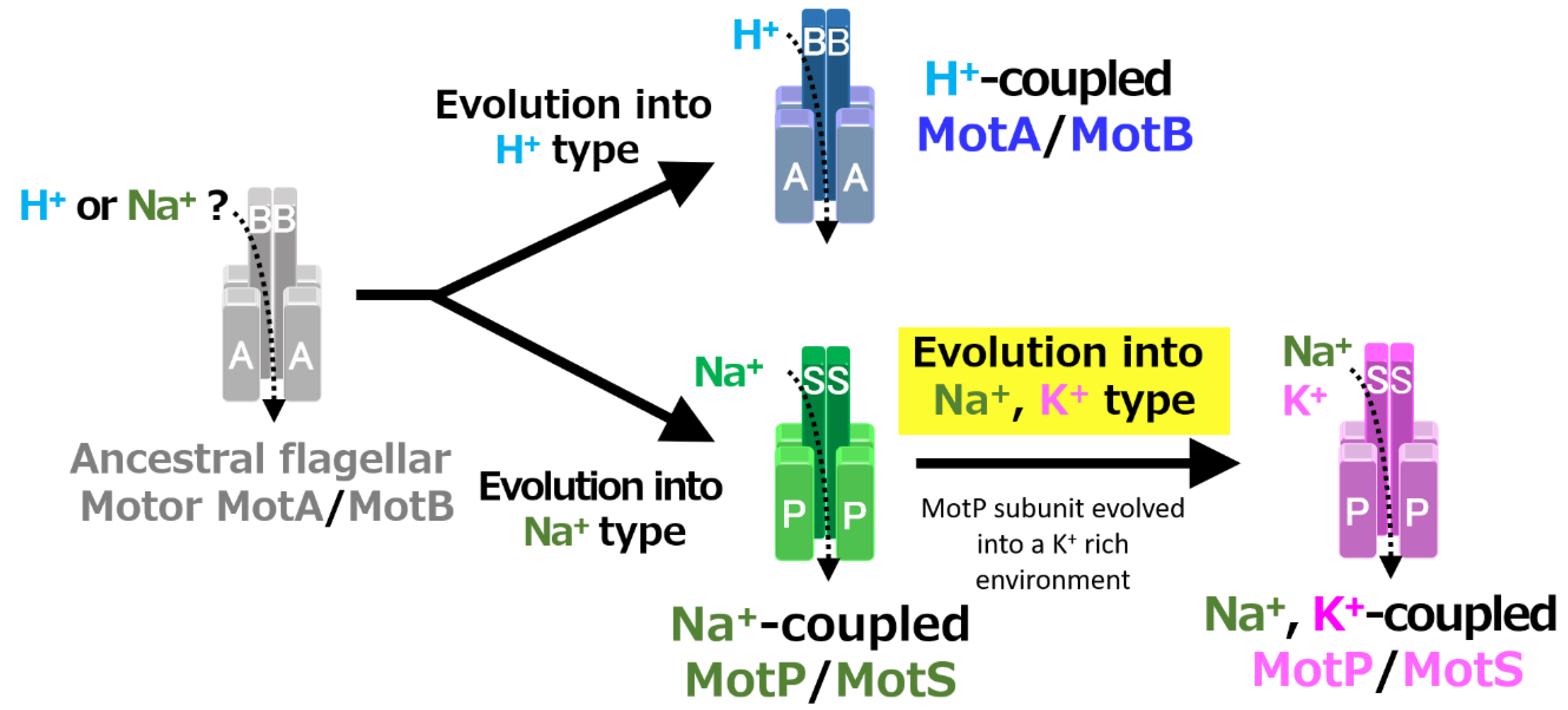
| Strain | Description | Source or Reference |
|---|---|---|
| Bacillus trypoxylicola | wild type (NBRC 102646) | [27] |
| Bacillus alcalophilus | wild type (JCM5652) | [28] |
| Bacillus pseudofirmus OF4 | wild type | [29] |
| Escherichia coli strains | ||
| W3110 | F- IN (rrnD-rrnE)1 | R. Aono |
| DH5αMCR | F- mcrAΔ1 (mrr-hsd RMS-mcrBC) Φ80dlacZ Δ(lacZYAargF) U169 deoR recA1 endA1 supE44 λthi-1 gyr-496 relA1 | Stratagene |
| RP6665 | ΔmotAB | J. S. Parkinson |
| Bt-PS | RP6665, pBAD24 + motPS from B. trypoxylicola | This study |
| Ba-PS | RP6665, pBAD24 + motPS from B. alcalophilus | This study |
| TK2420 | F- thi rha lacZ nagA Δ(kdpFAB) Δ(trk-mscL) trkD1 | [30] |
| TK-BtPS | TK2420, pBAD24 + motPS from B. trypoxylicola | This study |
| TK-BaPS | TK2420, pBAD24 + motPS from B. alcalophilus | [22] |
| TK-pBAD | TK2420, pBAD24 | [22] |
| HB101 | supE44, Δ(mcrC-mrr), recA13, ara-14, proA2, lacY1, galK2, rpsL20, xyl-5, mtl-1, leuB6, thi-1 | Takara Bio |
| HB-pBAD | HB101, pBAD24 | [22] |
| Bacillus subtilis strains | ||
| BR151MA | lys3 trpC2 (wild type) | [25] |
| ΔABΔPS | BR151MA ΔmotAB ΔmotPS | [31] |
| TTPS | ΔABΔPS lacA::PxylA-motPS from B. trypoxylicola | This study |
| OF4PS | ΔABΔPS lacA::PxylA-motPS from B. pseudofirmus | [23] |
| AAPS | ΔABΔPS lacA::PxylA-motPS from B. alcalophilus | This study |
| TPPS | ΔABΔPS lacA::PxylA-TP-motPS (motP from B. trypoxylicola, motS from B. pseudofirmus) | This study |
| PTPS | ΔABΔPS lacA::PxylA-PT-motPS (motP from B. pseudofirmus, motS from B. trypoxylicola) | This study |
| PAPS | ΔABΔPS lacA::PxylA-PA-motPS (motP from B. pseudofirmus, motS from B. alcalophilus) | This study |
| APPS | ΔABΔPS lacA::PxylA-AP-motPS (motP from B. alcalophilus, motS from B. pseudofirmus) | This study |
| TAPS | ΔABΔPS lacA::PxylA-TA-motPS (motP from B. trypoxylicola, motS from B. alcalophilus) | This study |
| ATPS | ΔABΔPS lacA::PxylA-AT-motPS (motP from B. alcalophilus, motS from B. trypoxylicola) | This study |
| Plasmid | Description | Source or Reference |
|---|---|---|
| pGEM7zf (+) | Cloning vector; ApR | Promega |
| pGEM-T Easy | TA-cloning vector; ApR | Promega |
| pBAD24 | Expression vector; ApR; PBAD promoter | [32] |
| pAX01 | lacA integration vector with EmR gene and PxylA promoter upstream of multiple cloning site | [33] |
| pGEM-T-BtPS | pGEM-T Easy + motPS from B. trypoxylicola | This study |
| pGEM-BtPS | pGEM7zf (+) + motPS from B. trypoxylicola | This study |
| pGEM-BpPS | pGEM7zf (+) + motPS from B. pseudofirmus | This study |
| pGEM-BaPS | pGEM7zf (+) + motPS from B. alcalophilus | This study |
| pGEM-tpPS | pGEM7zf (+) +tp-motPS (motP from B. trypoxylicola, motS from B. pseudofirmus) | This study |
| pGEM-taPS | pGEM7zf (+) +ta-motPS (motP from B. trypoxylicola, motS from B. alcalophilus) | This study |
| pGEM-ptPS | pGEM7zf (+) +pt-motPS (motP from B. pseudofirmus, motS from B. trypoxylicola) | This study |
| pGEM-paPS | pGEM7zf (+) +pt-motPS (motP from B. pseudofirmus, motS from B. alcalophilus) | This study |
| pGEM-atPS | pGEM7zf (+) +at-motPS (motP from B. alcalophilus, motS from B. trypoxylicola) | This study |
| pGEM-apPS | pGEM7zf (+) +at-motPS (motP from B. alcalophilus, motS from B. pseudofirmus) | This study |
| pBAD-BtPS | pBAD24 + motPS from B. trypoxylicola | This study |
| pBAD-BaPS | pBAD24 + motPS from B. alcalophilus | [22] |
| pAX-BtPS | pAX01 + motPS from B. trypoxylicola | This study |
| pAX-BaPS | pAX01 + motPS from B. alcalophilus | This study |
| pAX-tpPS | pAX01+tp-motPS (motP from B. trypoxylicola, motS from B. pseudofirmus) | This study |
| pAX-taPS | pAX01+ta-motPS (motP from B. trypoxylicola, motS from B. alcalophilus) | This study |
| pAX-ptPS | pAX01+pt-motPS (motP from B. pseudofirmus, motS from B. trypoxylicola) | This study |
| pAX-paPS | pAX01+pa-motPS (motP from B. pseudofirmus, motS from B. alcalophilus) | This study |
| pAX-atPS | pAX01+at-motPS (motP from B. alcalophilus, motS from B. trypoxylicola) | This study |
| pAX-apPS | pAX01+ta-motPS (motP from B. alcalophilus, motS from B. pseudofirmus) | This study |
© 2020 by the authors. Licensee MDPI, Basel, Switzerland. This article is an open access article distributed under the terms and conditions of the Creative Commons Attribution (CC BY) license (http://creativecommons.org/licenses/by/4.0/).
Share and Cite
Naganawa, S.; Ito, M. MotP Subunit is Critical for Ion Selectivity and Evolution of a K+-Coupled Flagellar Motor. Biomolecules 2020, 10, 691. https://doi.org/10.3390/biom10050691
Naganawa S, Ito M. MotP Subunit is Critical for Ion Selectivity and Evolution of a K+-Coupled Flagellar Motor. Biomolecules. 2020; 10(5):691. https://doi.org/10.3390/biom10050691
Chicago/Turabian StyleNaganawa, Shun, and Masahiro Ito. 2020. "MotP Subunit is Critical for Ion Selectivity and Evolution of a K+-Coupled Flagellar Motor" Biomolecules 10, no. 5: 691. https://doi.org/10.3390/biom10050691





